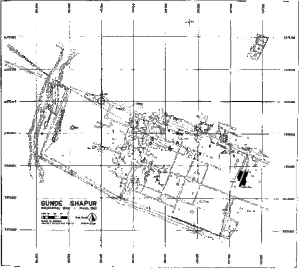Academy of Gondishapur


The Academy of Gondishapur (also Gundishapur or Gundeshapur, Persian: گندیشاپور; Syriac: Beth-Lapat) was the intellectual centre of the Sasanian Empire and the most important medical center of the ancient world during the 6th and 7th centuries.[1]
The city of Gondishapur itself is located in the present-day province of Khuzestan in southwestern Iran, not far from the Karun river.
History
The Academy of Gondishapur was founded in 271 by Shapur I and housed the oldest known teaching hospital, a library and a university. Subjects such as medicine, philosophy, theology and science were taught at the academy. The academy used Persian as well as Greek and Indian knowledge.
Under the rule of the Sassanid king Khosrow I Anushirvan ("with the immortal soul"; 531-579), Gondishapur became a well-known centre for medicine and science. Khosrow I gave asylum to numerous Greek philosophers, Aramaic Christians and Nestorian Christians fleeing religious persecution in the Byzantine Empire.
„And so the Emperor Justinian was also a henchman of certain entities when he, who was an enemy of everything that had come down from the high wisdom of Greekism, closed the schools of philosophy in Athens in 529, so that the last remnants of Greek scholarship with the high Aristotelian-Platonic knowledge were banished and fled over to Persia. The Syrian sages had already fled to Nisibis in the 5th century, when Zeno Isauricus had driven such Greek sages from Edessa. And so, towards the approach of the year 666, the Persian Academy of Gondishapur really gathered together that most exquisite scholarship which had come over from ancient Greece and which had taken no account of the Mystery of Golgotha. And within the Academy of Gondishapur taught those who were inspired by Luciferic-Ahrimanic forces.“ (Lit.:GA 182, p. 174)
The king commissioned the refugees to translate Greek and Aramaic texts into the Pahlavi (Middle Persian) language. Thus, various works of medicine, philosophy, astronomy and crafts were translated. However, the seven Neoplatonic philosophers who had fled to Persia in 531 saw their hopes dashed and returned to the Eastern Roman Empire as early as 532.
Khosrow I sent the well-known physician Burzoe to India to invite Indian and Chinese scholars to Gundishapur. These translated Indian texts on astronomy, mathematics, medicine and astrology as well as Chinese texts on herbal medicine and religion into (Middle) Persian. It is said of Burzoe that he himself translated the Panchatantra from Sanskrit into Persian.
When the Prophet Muhammad was born (between 570 and 573), the Academy was at the height of its glory.
Gondishapur was the scene of numerous Christian and Manichaean martyrdoms. Mani and the Christian Catholic Simon bar Sabbae died here. Gondishapur was the seat of a Christian metropolitan; in 484, at the Synod of Beth-Lapat, the teachings of Nestorius were established here as binding for Christians in the Persian Empire.
Archaeology
The town has never been the target of major excavations. In 1963, the site was briefly examined during a survey, which at least gave a rough idea of the former appearance of the city. The ruins are spread over an area of about 3 x 2 km. The streets of the city are laid out in a chessboard pattern, which may indicate a Greek foundation, perhaps the work of the city's inhabitants who came from Antioch. This corresponds with the description of Arab geographers such as Hamza al-Isfahani and Yaqut al-Hamawi, who report that the city was criss-crossed in its length and width by eight streets each, which met at right angles.
Literature
- The Cambridge History of Iran. Bd. 3–4, Cambridge 1983ff.
- George Ghevarghese Joseph: In his Crest of the Peacock. Princeton University Press, 2000 (with reference to the importance of the Academy for the history of mathematics).
- Friedrun R. Hau: Gondeschapur. Eine Medizinschule aus dem 6. Jahrhundert n. Chr. Gesnerus, XXXVI/1979, S. 98-115.
- Heinz Herbert Schöffler: Die Akademie von Gondischapur. Aristoteles auf dem Wege in den Orient. Mit eineem Geleitwort von Friedrich Hiebel. 2. Aufl., Stuttgart 1980 (= Logoi 5), ISBN 3-7725-0701-8.
- Heinz Herbert Schöffler: Die Akademie von Gondischapur und der Impuls von 666. In: Flensburger Hefte Nr. 61, Flensburg 1998, S. 14 - 43
- Paul Emberson: Von Gondishapur bis Silicon Valley Band I, Etheric Dimensions Press, Schweiz und Schottland 2012 - kritische Betrachtung: A well intended very flawed Book
- Paul Emberson: From Gondishapur to Silicon Valley, Volume II, Etheric Dimensions Press, Switzerland and Scottland 2014 (deutsche Übersetzung in Vorbereitung)
- Rudolf Steiner: Der Tod als Lebenswandlung, GA 182 (1996), ISBN 3-7274-1820-6 English: rsarchive.org German: pdf pdf(2) html mobi epub archive.org
- Rudolf Steiner: Die Polarität von Dauer und Entwickelung im Menschenleben. Die kosmische Vorgeschichte der Menschheit., GA 184 (2002), ISBN 3-7274-1840-0 English: rsarchive.org German: pdf pdf(2) html mobi epub archive.org
 |
References to the work of Rudolf Steiner follow Rudolf Steiner's Collected Works (CW or GA), Rudolf Steiner Verlag, Dornach/Switzerland, unless otherwise stated.
Email: verlag@steinerverlag.com URL: www.steinerverlag.com. Index to the Complete Works of Rudolf Steiner - Aelzina Books A complete list by Volume Number and a full list of known English translations you may also find at Rudolf Steiner's Collected Works Rudolf Steiner Archive - The largest online collection of Rudolf Steiner's books, lectures and articles in English. Rudolf Steiner Audio - Recorded and Read by Dale Brunsvold steinerbooks.org - Anthroposophic Press Inc. (USA) Rudolf Steiner Handbook - Christian Karl's proven standard work for orientation in Rudolf Steiner's Collected Works for free download as PDF. |
Weblinks
- The Medical Sciences in the Avesta
- Auszüge aus dem Flensburger Heft Nr. 61: Die Hintergründe von 666
- Dols, Michael W. (1987). The Origins of the Islamic Hospital: Myth and Reality. Bulletin of the History of Medicine. 61 (3): 367–391. PMID 3311248 jstor.org
References
- ↑ The Cambridge History of Iran, Vol 4, p396. ISBN 0-521-20093-8
